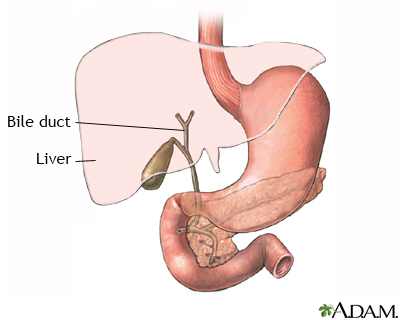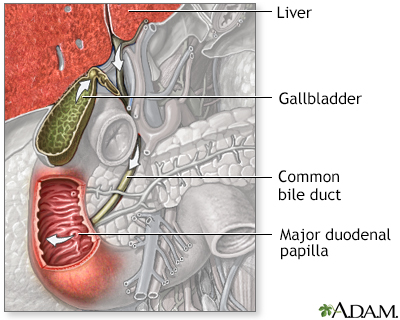Pregnancy SmartSiteTM
PTC; Cholangiogram - PTC; PTC; PBD - Percutaneous biliary drainage; Percutaneous transhepatic cholangiography DefinitionA percutaneous transhepatic cholangiogram (PTC) is an x-ray of the bile ducts. These are the tubes that carry bile from the liver to the gallbladder and small intestine. How the Test is PerformedThe test is performed in a radiology department by an interventional radiologist. You will be asked to lie on your back on the x-ray table. The provider will clean the upper right and middle area of your belly area and then apply a numbing medicine. X-rays and ultrasound are used to help the health care provider locate your liver and bile ducts. A long, thin, flexible needle is then inserted through the skin into the liver. The provider injects dye, called contrast medium, into the bile ducts. Contrast helps highlight certain areas so they can be seen. More x-rays are taken as the dye flows through the bile ducts into the small intestine. This can be seen on a video monitor. You will be given medicine to calm you (sedation) for this procedure. Rarely, you may receive general anesthesia, so you will be asleep. How to Prepare for the TestInform your provider if you are pregnant or have a bleeding disorder. You will be given a hospital gown to wear and you will be asked to remove all jewelry. You will be asked not to eat or drink anything for 6 hours prior to the exam. Tell your provider if you are taking any blood thinners such as Warfarin (coumadin), Plavix (clopidogrel), Pradaxa, or Xarelto. How the Test will FeelThere will be a sting as the anesthetic is given. You may have some discomfort as the needle is advanced into the liver. You will have sedation for this procedure. Why the Test is PerformedThis test can help diagnose the cause of a bile duct blockage. Bile is a liquid released by the liver. It contains cholesterol, bile salts, and waste products. Bile salts help your body break down (digest) fats. A blockage of the bile duct can lead to jaundice (yellow discoloration of the skin), itching of the skin, or infection of the liver, gallbladder or pancreas. When it is performed, PTC is most often the first part of a two-step process to relieve or treat a blockage.
Normal ResultsThe bile ducts are normal in size and appearance for the age of the person. What Abnormal Results MeanThe results may show that the ducts are enlarged. This may mean the ducts are at least partially blocked. The blockage may be caused by scarring or stones. It may also indicate cancer in the bile ducts, liver, pancreas, or gallbladder. RisksThere is a slight chance of an allergic reaction to the contrast medium (iodine). There is also a small risk for:
ConsiderationsMost of the time, this test is done after an endoscopic retrograde cholangiopancreatography (ERCP) test has been tried first. The PTC may be done if an ERCP test cannot be performed or has failed to clear the blockage. A magnetic resonance cholangiopancreatography (MRCP) is another, noninvasive imaging method, based on magnetic resonance imaging (MRI). It also provides views of the bile ducts, but it is not always possible to do this exam. Also, MRCP cannot be used to treat the blockage. ReferencesCameron J. Gallbladder and biliary tree. In: Cameron J, ed. Current Surgical Therapy. 14th ed. Philadelphia, PA: Elsevier; 2023:chap 8. James TW, Baron TH. Endoscopic and radiologic treatment of biliary disease. In: Feldman M, Friedman LS, Brandt LJ, eds. Sleisenger and Fordtran's Gastrointestinal and Liver Disease. 11th ed. Philadelphia, PA: Elsevier; 2021:chap 70. Radkani P, Hawksworth J, Fishbein T. Biliary system. In: Townsend CM Jr, Beauchamp RD, Evers BM, Mattox KL, eds. Sabiston Textbook of Surgery. 21st ed. St Louis, MO: Elsevier; 2022:chap 55. | |
| |
Review Date: 1/7/2023 Reviewed By: Jason Levy, MD, FSIR, Northside Radiology Associates, Atlanta, GA. Also reviewed by David C. Dugdale, MD, Medical Director, Brenda Conaway, Editorial Director, and the A.D.A.M. Editorial team. The information provided herein should not be used during any medical emergency or for the diagnosis or treatment of any medical condition. A licensed medical professional should be consulted for diagnosis and treatment of any and all medical conditions. Links to other sites are provided for information only -- they do not constitute endorsements of those other sites. No warranty of any kind, either expressed or implied, is made as to the accuracy, reliability, timeliness, or correctness of any translations made by a third-party service of the information provided herein into any other language. © 1997- A.D.A.M., a business unit of Ebix, Inc. Any duplication or distribution of the information contained herein is strictly prohibited. | |

 Gallbladder anatom
Gallbladder anatom Bile pathway
Bile pathway
